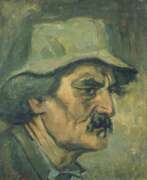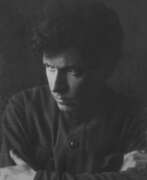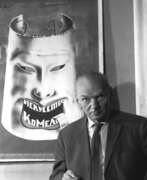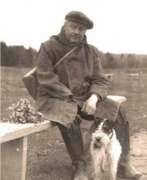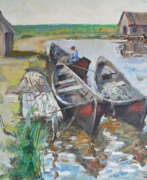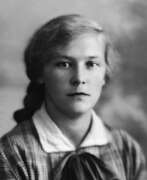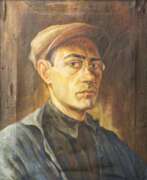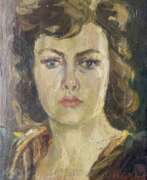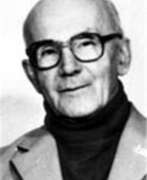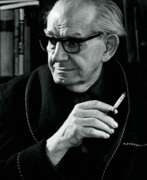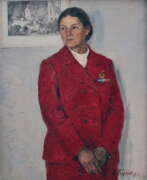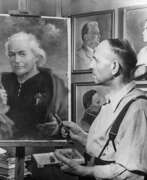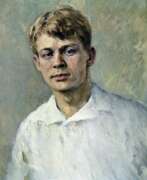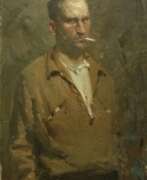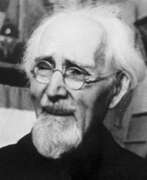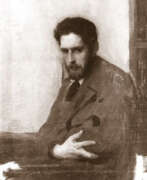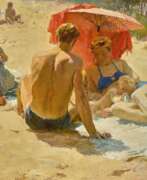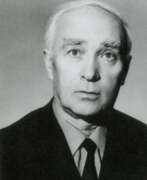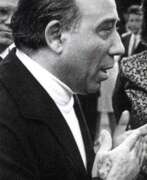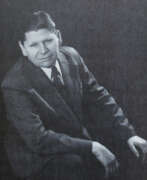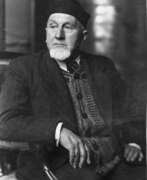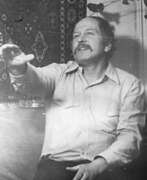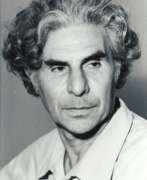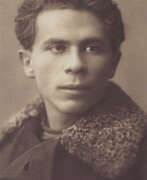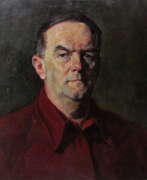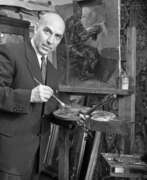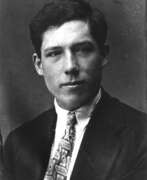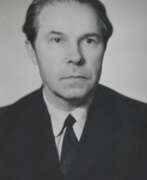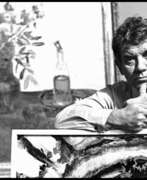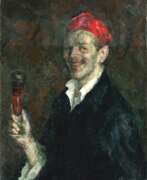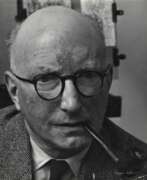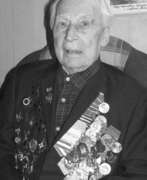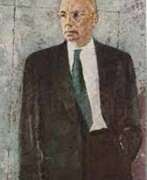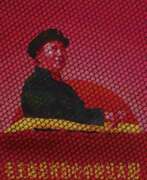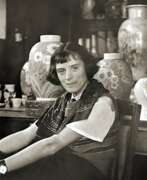Portrait Socialist realism
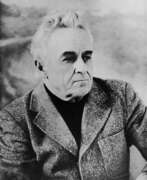

Alexander Grigorievich Maksymenko (Russian: Александр Григорьевич Максименко) was a Soviet and Ukrainian painter of the second half of the twentieth and early twenty-first centuries. He is known as a painter, graphic artist, watercolorist, and art historian.
Alexander Maksymenko worked in the genres of still life, landscape, portrait, as well as in genre painting. His genre works cover themes of collective farm life, including "Masters of the Land" and "Innovators of Collective Farm Fields". For the latter work he received the Stalin Prize. The master actively participated in exhibitions in Ukraine and abroad. His works are in the National Art Museum of Ukraine, the Museum of the History of Ukraine in World War II, as well as in other art museums and private collections.
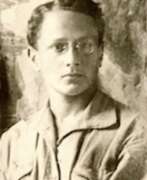

Pavel Efimovich Ab (Russian: Павел Ефимович Аб) was a Russian Soviet artist, born on November 22, 1902, in Orel. He is renowned for his contributions to painting and graphic arts, having studied under notable mentors such as Kuzma Petrov-Vodkin and A. I. Savinov at the VKhUTEIN in Leningrad during the years 1923 to 1929.
Ab's career was deeply influenced by his experiences during the Great Patriotic War, where he served in the 21st Rifle Division of the NKVD on the Leningrad Front. His war-time sketches of city defenders and subsequent military honors played a significant role in his artistic expression. After the war, he continued to actively participate in the creative community, producing notable works like "Pavlov in Koltushi" and "Speech of V. I. Lenin at the Admiralty Shipyards".
His artworks, which often depicted military and historical themes, are preserved in various museums and private collections in Russia and abroad. Ab's commitment to the Leningrad Union of Artists until his death in 1974 ensured that his legacy would influence future generations of artists.
For enthusiasts and collectors keen on exploring Russian Soviet art, staying updated on exhibitions and sales featuring Pavel Efimovich Ab's works can be enriching. Sign up here for updates related to new product sales and auction events concerning Ab's art.


Victor Ashotovich Abramyan (Russian: Виктор Ашотович Абрамян) was a Soviet and Russian artist of the second half of the twentieth and early twenty-first centuries. He is known as a painter, a representative of the Leningrad school.
Victor Abramyan created portraits, landscapes, still lifes and genre paintings. He participated in exhibitions from the early 1970s in Leningrad. Among his famous works are "Blockade everyday life", "Still Life with a Centennial", "Leningrad. 1942. Women on Guard in the besieged city", "Young Guests" and others.
Abramyan's works are in museums and private collections in Russia and many other countries.
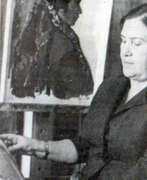

Yevgeniya Mikhailovna Adamova (Russian: Евгения Михайловна Адамова) was a Soviet artist of the second half of the twentieth century. She is known as a painter, People's Artist of the Turkmen SSR.
Yevgeniya Adamova, who moved to Turkmenistan from Ukraine in her youth, was educated at the Ashgabat Art School. During the Great Patriotic War, she creatively expressed herself as a poster artist in the TurkmenTAG agency. The artist created thematic paintings dedicated to the life of the Turkmen people and portraits. She held the post of deputy chairman of the Union of Artists of Turkmenistan.
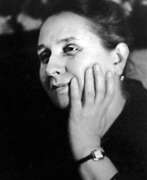

Taisia Kirillovna Afonina (Russian: Таисия Кирилловна Афонина) was a Soviet artist of the second half of the twentieth century. She is known as a painter, graphic artist, representative of the Leningrad school.
Taisia Afonina participated in exhibitions since 1940, creating portraits, landscapes, genre compositions, still lifes and etudes. At the beginning of her career she was interested in military subjects, and then delved into the genre of portraiture and lyrical landscape. Her style is characterized by tonal painting, the rendering of light and air environments and subtle coloristic combinations. In the 1980s she preferred the watercolor technique, painting flowers such as roses, daisies and tulips. Her works are in museums and private collections in Russia and other countries.
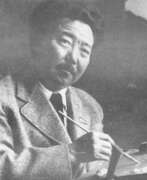

Gapar Aitievich Aitiev (Russian: Гапар Айтиевич Айтиев), a pioneering figure in Soviet Kyrgyz art, was born in 1912 and became a cornerstone of Kyrgyz cultural heritage through his impactful contributions as an artist and educator. Aitiev's journey in art began at the Moscow Art School in Memory of 1905, where he studied under N. P. Krymov between 1935 and 1938, laying the groundwork for his illustrious career. His profound connection to his Kyrgyz roots was reflected in his artwork, characterized by epic, poetic landscapes of Kyrgyzstan, such as "Midday on Issyk Kul" (1954), and detailed portraits like the "Gallery of portraits of contemporaries" (1979). Aitiev's contributions to the art world earned him the prestigious titles of People’s Artist of the USSR and Hero of Socialist Labor, marking his influence on Soviet and Kyrgyz art history.
The Gapar Aitiev Kyrgyz National Museum of Fine Arts, named in his honor, stands as a testament to his legacy, showcasing not only his work but also a broad spectrum of Kyrgyz and Russian art, spanning from traditional Kyrgyz artifacts to contemporary works post-independence. This museum, alongside the Gapar Aitiev Memorial Studio Museum in Bishkek, provides insight into Aitiev's life, offering a personal glance at his workspaces and the art that filled his surroundings. These institutions preserve and celebrate Aitiev's dedication to portraying the tranquil beauty of Kyrgyz landscapes and the spirit of its people, making his work an integral part of Kyrgyz national identity.
For those interested in the rich tapestry of Central Asian art, visiting these museums in Bishkek is a journey through the heart of Kyrgyz culture and history, brought alive by Aitiev's artistic vision. His work not only captures the essence of Kyrgyzstan's landscapes and people but also serves as a bridge between the traditional and the modern, embodying the nation's cultural evolution.
To stay updated on exhibitions and events celebrating Gapar Aitievich Aitiev's legacy and to explore more about his contributions to art and culture, consider signing up for updates. This subscription will keep you informed about new product sales and auction events dedicated to Aitiev's work, ensuring that enthusiasts and collectors alike remain connected to the vibrant world of Kyrgyz art.
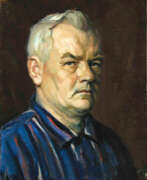

Ivan Osipovich Akhremchik (Russian: Ива́н О́сипович Ахре́мчик) was a twentieth-century Belarusian Soviet artist. He is known as a painter and teacher.
Ivan Akhremchik worked in the genres of portrait, thematic painting, landscape and monumental art. He was one of the first Belarusian artists turned in his work to the theme of the establishment of Soviet power and socialist construction in Belarus. As a muralist, the artist participated in the creation of several pictorial panels for exhibitions and cultural institutions of Belarus.


Pyotr Filippovich Alberti (Russian: Пётр Филиппович Альберти) was a Soviet and Russian artist of the second half of the twentieth century. He is known as a painter, a representative of the Leningrad school.
Pyotr Alberti created portraits, landscapes, genre paintings. He actively exhibited since 1951 in Leningrad, demonstrating his works along with the masters of his time. The artist had a broad writing and bright coloring, expressive stroke and used various techniques. He paid special attention to the study of nature. In the late period of his career, he became fond of still life paintings with favorite motifs such as peonies and watermelons.
Alberti's works are preserved in museums and collections around the world.


Valery Vladimirovich Androsov (Russian: Валерий Владимирович Андросов) is a Soviet and contemporary Russian artist. He is known as a sculptor, architect, designer, painter, graphic artist and teacher.
Valery Androsov creates landscapes, still lifes and portraits, as well as fantasy works. He is also known as the author of a large collection of ex-libris that accurately convey the character and interests of book owners. At different periods he served as chief artist of the Mosstroiplastmass Combine and director of the Mytishchi Picture Gallery. He also created monuments to those who died in the Great Patriotic War and to the pilots of the Mytishchi Aero Club, showing his skill in various artistic directions.
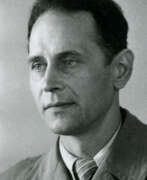

Vladislav Leopoldovich Anisovich (Russian: Владислав Леопольдович Анисович) was a Soviet artist of the mid-twentieth century. He is known as a painter, graphic artist and teacher, a representative of the Leningrad school of painting.
Vladislav Anisovich participated in various exhibitions since 1935. His work included portraits, historical and genre compositions, as well as landscapes. Among the famous paintings of the artist are "The passage of K. Voroshilov's detachment from Lugansk to Tsaritsyn", "Assault on Perekop" and others. The master taught at the Leningrad Institute of Painting, Sculpture and Architecture.
His works are in various museums and private collections in many countries, including the State Russian Museum.
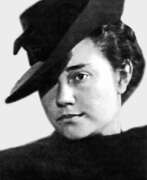

Evgenia Petrovna Antipova (Russian: Евгения Петровна Антипова) was a notable Russian painter, graphic artist, and art teacher. She stood out for her genre compositions, portraits, landscapes, and still lifes, primarily utilizing oils and watercolors. Evgenia Antipova's works often depicted apple orchards and Crimean landscapes, showcasing her profound connection to nature and her ability to capture its essence.
Evgenia Antipova's education at the prestigious Repin Institute of Arts shaped her artistic journey, leading to a career enriched with personal exhibitions and a significant presence in the art community. Not only did her artworks gain recognition in Russia, but they also found their way into international collections and exhibitions, notably in France, Germany, the United States, and the United Kingdom.
Throughout her career,Evgenia Antipova was an active participant in various significant exhibitions, displaying her works alongside other renowned artists. Her contributions to the art world were recognized with personal exhibitions in Saint Petersburg and inclusion in art auctions and exhibitions abroad.
Evgenia Antipova's paintings are part of prestigious collections, including the State Russian Museum, and continue to be celebrated in art museums and private collections globally. Her legacy as a prominent figure in the Leningrad School of painting endures, captivating art enthusiasts and collectors with her vivid and emotionally resonant works.
For those interested in Russian art, particularly the Leningrad School of painting, Evgenia Petrovna Antipova's oeuvre offers a rich exploration of genre compositions and landscapes, reflecting the artistic vibrancy of her era. Collectors and art experts are encouraged to delve into her works and consider signing up for updates on exhibitions and sales featuring her paintings.
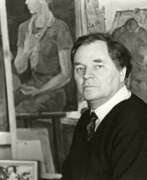

Fyodor Vasilievich Antonov (Russian: Фёдор Васильевич Антонов) was a Soviet and Russian artist of the twentieth century. He is known as a painter, graphic artist, textile artist, teacher, and professor.
Fyodor Antonov created landscapes, portraits and thematic compositions. In his genre works he immortalized the life and life of Soviet youth, as well as the formation of industry in the USSR. During the Great Patriotic War, the artist created portraits of heroes, as well as posters with a simple and direct pictorial form. Antonov's works are in various museum collections, including the Tretyakov Gallery, the Russian Museum and many private collections.


Pyotr Yakovlevich Anurin (Russian: Петр Яковлевич Анурин) was a Soviet and Russian artist of the second half of the twentieth century. He is known as a painter, author of lyrical landscapes, often depicting the architecture of ancient Russian cities.
Pyotr Anurin was nicknamed "spring artist" by his contemporaries for his subject matter, style and technique of painting. Spring was a special time for the master, during this period he created many canvases, such as "Spring", "The Last Snow" and others. The main theme of his works in the last years of his life was the Central Russian landscape.
The artist's works are in various art galleries and private collections in many countries, including Russia, England, Germany, France, Israel and China.
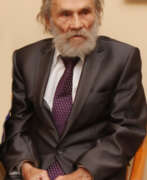

Boris Vladimirovich Arakcheyev (Russian: Борис Владимирович Аракчеев) was a Soviet and Belarusian artist of the second half of the twentieth and early twenty-first centuries. He is known as a painter and teacher.
Boris Arakcheyev worked in easel painting in the genres of landscape, still life, thematic paintings and battle scenes. A series of portraits of contemporaries and famous people occupies a special place in his creative heritage. He also worked in monumental painting - he was one of the creators of the diorama "Minsk Cauldron" in the Museum of the History of the Great Patriotic War of Belarus.
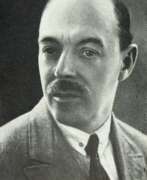

Anatoly Afanasyevich Arapov (Russian: Анатолий Афанасьевич Арапаов) was a Russian and Soviet artist, born in St. Petersburg in 1876 and passing away in Moscow in 1949. His artistic journey began after graduating from high school in 1892, leading him to study at the Moscow Boundary Institute where he initially acquired artistic skills. Arapov's dedication to art became undeniable, prompting him to enroll in the Moscow School of Painting, Sculpture and Architecture in 1897, where he was deeply involved in applied art, book design, and theater.
Arapov's early works, particularly around 1900 and 1910, were influenced by Symbolism, but he transitioned through a phase of Constructivism in the 1920s before dedicating himself to Socialist Realism from the 1930s onward. His versatile talent spanned across painting, graphic arts, and set design, making significant contributions to theater and film. Notably, he designed plays for leading theaters across major Russian cities and worked on popular films in the 1920s and 1930s.
His oeuvre includes portraits, still lifes, and landscapes, featuring views of ancient parks and Russian architecture. Arapov's works are celebrated for their stylistic diversity, capturing the essence of Symbolism, Constructivism, and Socialist Realism. His contributions are recognized in museum collections, including the State Tretyakov Gallery and the Saratov State Art Museum named after Radishchev, among others.
For collectors and art experts, Arapov's works offer a glimpse into the evolving art styles of early to mid-20th century Russia. To stay informed on sales and auction events featuring Anatoly Afanasyevich Arapov's art, signing up for updates can provide exclusive access to new discoveries and opportunities to acquire pieces by this multifaceted artist.
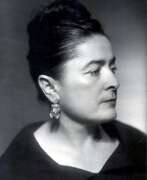

Yeranui Arshakovna Aslamazyan (Russian: Ерануи Аршаковна Асламазян) was a Soviet and Russian artist of the second half of the twentieth century of Armenian origin. She is known as a painter and graphic artist.
Yeranui Aslamazyan created portraits, landscapes, still lifes and genre paintings. She also experimented with theater design, prints and ceramics. An Orientalist artist, she was part of the Soviet artistic elite in Leningrad and Moscow. With the support of the Soviet Union authorities, she traveled the world, visiting many countries. Her works are in museums in London, Sofia, Berlin, St. Petersburg, Venice, Tokyo, and Delhi.


Mariam Arshaki Aslamazyan (Russian: Мариам Аршаковна Асламазян) was a renowned Soviet-Armenian painter, often hailed as the "Armenian Frida Kahlo" due to her vibrant and expressive works that prominently featured elements of Armenian culture. Born on October 20, 1907, in Alexandropol (now Gyumri), Armenia, Aslamazyan was celebrated for her unique style which blended traditional Armenian themes with modernist influences.
Throughout her career, Aslamazyan's artwork received significant accolades, including the prestigious titles of People's Artist of the Armenian SSR in 1965 and People's Artist of the Soviet Union in 1990. Her paintings are characterized by their vivid colors and dynamic compositions, often focusing on still lives, narrative scenes, and portraits.
Aslamazyan's works are preserved and displayed in several major collections, notably at the Gallery of Mariam and Eranuhi Aslamazyan Sisters in her hometown, which showcases an extensive array of her oil paintings and ceramic works. Her artistic legacy continues to be celebrated in exhibitions and holds a significant place in Armenian cultural heritage.
For those interested in exploring more about Mariam Arshaki Aslamazyan's life and art, or in acquiring works associated with her, consider subscribing for updates on new product sales and auction events related to her work. This subscription will keep you informed about opportunities to engage with Aslamazyan's art legacy.
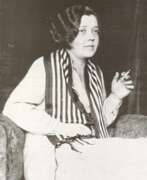

Zinaida Antonovna Astapovich-Bocharova (Russian: Зинаида Антоновна Астапович-Бочарова) was a Russian, Soviet and Belarusian artist of the twentieth century. She is known as a painter, graphic artist and teacher.
Zinaida Astapovich-Bocharova worked in the genres of portrait, landscape, propaganda poster, as well as book illustration - mainly for fairy tale books. She painted in watercolor, oil, pencil, charcoal, gouache, and pastel. Much of her work from the 1930s and 1940s was lost during the evacuation of the artist from besieged Leningrad.
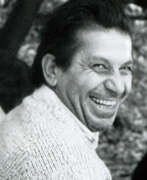

Robert Petrosovich Avakyan (Russian: Роберт Петросович Авакян) was a Soviet and Uzbek artist of the second half of the twentieth and early twenty-first centuries of Armenian origin. He is known as a painter, graphic artist, sculptor and teacher.
Robert Avakyan was trained in painting, but he is most famous as an author of monumental sculptures. He worked actively in Tashkent, participating in numerous exhibitions, including international sculpture competitions. The master also left his mark in such Uzbek cities as Bukhara, Nukus and Yangibazar, where he created significant monumental works.
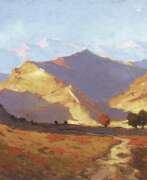

Gennady Fyodorovich Babikov (Russian: Геннадий Фёдорович Бабиков) was a Soviet and Turkmen artist of the twentieth century. He is known as a painter, graphic artist, watercolorist, master of landscape and still life and is considered the founder of the genre of Turkmen industrial landscape, representative of the Russian academic school of painting in Central Asia.
Gennady Babikov participated in the Great Patriotic War, at the front he created more than 100 graphic portraits of fellow soldiers. The artist was famous for his linocuts, and also developed a still life style, which was called "Babikov's" in Turkmenistan.
His works are in many private collections around the world.
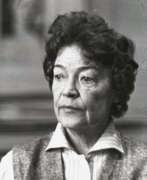

Aino Bach (Russian: Айно Густавовна Бах) was an Estonian and Soviet artist of the twentieth century. She is known as a painter, graphic artist and printmaker.
Aino Bach was one of the first Estonian printmakers to demonstrate mastery of the intaglio technique, which expanded the possibilities of engraving. Her work includes portraits, genre compositions and illustrations. She employed a variety of techniques including gravure printing, metal engraving, and color monotype. Her works often combined different techniques, giving them a distinctive flavor.
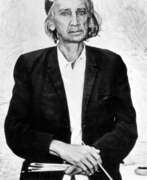

Sattar Bahlulzade (Russian: Саттар Бахлул оглы Бахлулзаде) was a 20th-century Azerbaijani Soviet landscape painter. He is known as a painter, graphic artist, landscape painter and caricaturist.
Bahlulzade created lyrical landscapes praising Azerbaijani nature, which were characterized by realism and detail. As a classical landscape painter he was especially famous for his second period of creativity (1940-1960). The artist's paintings were closely intertwined with the traditions of Azerbaijani art, and in the last years of his life the influence of Neo-Impressionism was manifested. Bahlulzade also created graphic works, including still lifes.
World museums preserve about 150 paintings and 30 graphic works by this artist.
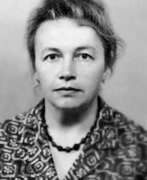

Irina Mikhailovna Baldina (Russian: Ирина Михайловна Балдина) was a Soviet and Russian artist of the second half of the twentieth and early twenty-first centuries. She is known as a painter, a representative of the Leningrad school.
Irina Baldina participated in exhibitions in Leningrad since 1952. Her work covered a variety of genres, including portraits, landscapes, still lifes and genre compositions. From 1960 to 1980, her works were characterized by themes of modernity, nature and people of Zaonezhye. Her style was characterized by broad brushstrokes, decorative and mastery in conveying the colors of northern nature.
Her works are in museums and private collections all over the world, including Russia, France, USA, Japan and other countries.
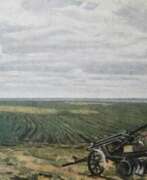

Vasily Nikolaevich Basov (Russian: Василий Николаевич Басов) was a Soviet artist of the mid-twentieth century. He is known as a painter, graphic artist, and representative of socialist realism in art. His oeuvre includes landscapes, portraits and genre paintings, with a special focus on rural subjects.
Since 1943 Vasily Basov actively participated in exhibitions, both national and international. His works have been exhibited in various countries, including Poland, China, Bulgaria and Romania.
Basov's works are in the collections of the State Tretyakov Gallery, the State Art Museum of the Altai Territory and other museums, as well as in private collections.
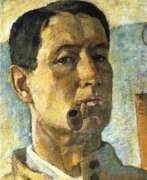

Veniamin Pavlovich Belkin (Russian: Вениамин Павлович Белкин), a distinguished Russian and Soviet artist, was born in 1884 and made significant contributions to the fields of painting, graphic arts, and teaching until his death in 1951. His extensive teaching career included positions at prestigious institutions such as the Higher Institute of Photos and Photo Equipment, the Baron A.L. Stieglitz Central School of Technical Drawing, Vhuteine, the State Architectural Institute, and the Leningrad Institute of Painting, Sculpture, and Architecture named after Ilya Repin. In 1955, a memorial exhibition in Leningrad posthumously honored his artistic legacy.
Belkin's artworks, characterized by their depth and artistic integrity, are held in high regard within major museum collections, including the State Tretyakov Gallery and the State Russian Museum, as well as various regional museums. His contributions to Russian art are celebrated for their historical and cultural significance, bridging the gap between pre-revolutionary and Soviet art.
For collectors and experts in art and antiques, Belkin's work represents an intriguing investment, embodying the rich tapestry of Russian history and culture. His legacy continues to inspire and influence contemporary art, making his pieces sought after by connoisseurs around the world.
Sign up for updates to stay informed about new product sales and auction events related to Veniamin Pavlovich Belkin, and enrich your collection with the works of one of Russia's most venerable artists.
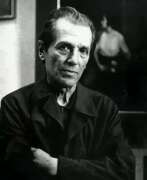

Piotr Petrovich Belousov (Russian: Пётр Петро́вич Белоу́сов) was a distinguished Soviet and Russian artist, born on May 3, 1912, in Berdyansk, and passed away on March 31, 1989, in Leningrad. He is widely celebrated for his contributions to the Leningrad School of Painting, having been an influential figure in shaping the artistic landscape of the region. His expertise extended across various mediums, including painting, etching, and graphic arts, with a notable focus on themes like the Bolshevik Revolution and historical Soviet figures like Lenin.
Belousov's educational and professional journey was deeply intertwined with the prestigious Ilya Repin Leningrad Institute of Painting, Sculpture and Architecture, where he both studied and later taught, eventually rising to the rank of professor and head of the drawing department by 1956. His career was marked by numerous accolades, including the titles of Honored Artist and People's Artist of the RSFSR, reflecting his significant impact on Russian art and education.
Throughout his life, Belousov participated in many exhibitions and his works are held in high esteem, not only in Russian state museums like the Russian Museum and the Tretyakov Gallery but also internationally. His pieces, particularly those that capture key moments in Soviet history and urban landscapes, remain influential and are sought after by collectors around the worl.
For enthusiasts of Soviet art and collectors interested in Belousov's works, staying updated on exhibitions and sales can provide valuable opportunities to acquire his art. To receive alerts about new product sales and auction events featuring Piotr Petrovich Belousov's works, signing up for updates is highly recommended.
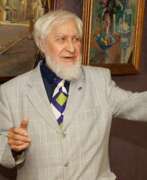

Yuri Vladimirovich Belov (Russian: Юрий Владимирович Белов) was a Soviet and Russian artist of the second half of the twentieth and early twenty-first centuries. He is known as a painter, a representative of the Leningrad school, who worked in the genres of portrait, landscape, still life and historical painting.
Yuri Belov actively participated in exhibitions since 1954. In 1960-1980 the main theme of his work was the images of Lenin and the history of the revolutionary movement. The artist's manner evolved from strict objectivism to a more decorative and impressionistic style.
The master's works are in museums in Russia, France, the USA, Germany and other countries, as well as in private collections.
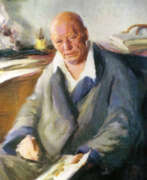

Pavel Petrovich Benkov (Russian: Павел Петрович Беньков) was a Russian and Soviet artist of the first half of the twentieth century. He is known as a painter, graphic artist, theater decorator, and teacher.
Pavel Benkov created portraits, landscapes, cityscapes, genre paintings. His style in his mature years can be described as impressionist, with attention to color and light. In 1929 he moved to Central Asia, where his style took on unique characteristics, reflecting local landscapes and culture. His work has had a significant influence on the painting traditions of Uzbekistan and Central Asia.
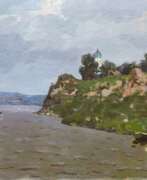

Yakov Tarasovich Besperstov (Russian: Яков Тарасович Бесперстов) was a Russian Soviet artist of the second half of the twentieth century. He is known as a painter, muralist, representative of the Leningrad school of painting.
At the initial stage of his career, Yakov Besperstov worked in the field of monumental and decorative painting, participating in the painting of various buildings. Later he moved to easel painting, creating portraits, genre paintings, as well as urban landscapes. His works were exhibited at exhibitions from the late 1950s and were appreciated by leading artists of Leningrad. The master traveled extensively throughout various regions of Russia and other countries, including France.
His works are in museums and private collections in various countries, including Russia, France, Belgium, Germany, Spain and Italy.
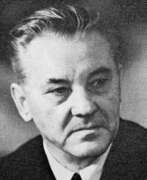

Georgy Nikolaevich Bibikov (Russian: Георгий Николаевич Бибиков) was a Russian and Soviet artist of the mid-20th century. He is known as a painter, graphic artist, illustrator, muralist and theater artist of the Leningrad school, working in the genres of landscape, portrait, still life and thematic painting.
Georgy Bibikov began participating in art exhibitions in 1920. Among his famous works are "Loaders", "Young Red Fleets Receive Uniforms", "Greetings to the Winners", "Trench Truth" and others. His works are in the State Russian Museum and in museums and private collections in Russia, Ukraine, Germany and France.
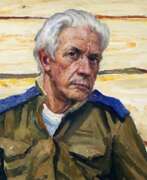

Mikhail Grigorievich Bogatyryov (Russian: Михаил Григорьевич Богатырёв) was a Soviet and Russian artist of the second half of the twentieth century. He is known as a painter.
Mikhail Bogatyryov participated in the Great Patriotic War, was wounded and became disabled. His work focused on the theme of war and the life of rural toilers. He also created works in the genres of still life and landscape. His paintings are in museum collections, including Russian regional art galleries, as well as private collections in Russia and abroad, including countries such as France, Japan, Germany and Italy.
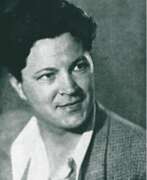

Fyodor Semyonovich Bogorodsky (Russian: Фёдор Семёнович Богородский) was a distinguished Russian painter, graphic artist, and theatrical designer, celebrated for his contributions to Soviet art. Born in Nizhny Novgorod and initially studying law at Moscow University, Bogorodsky's passion for art led him to VKhUTEMAS, where he honed his craft under notable figures such as A.E. Arkhipov. His unique journey included serving as a sailor and pilot during World War I, which profoundly influenced his art, often depicting sailors as his main subjects, a testament to his own experiences and admiration for their lifestyle.
Bogorodsky's artistry earned him the title of Honored Artist of the RSFSR in 1946, and his work "Glory to Fallen Heroes" received the prestigious Stalin Prize in 1945, later commemorated on a Soviet postage stamp in 1965. His commitment to depicting the valor and hardships of the Soviet people, especially sailors and the underprivileged, made him a significant figure in the realm of Soviet realism.
His works are preserved in esteemed collections, including the State Tretyakov Gallery and the State Russian Museum, showcasing his contributions to Soviet art and culture. Bogorodsky's legacy extends beyond his paintings, as he also made significant contributions to the fields of teaching, poetry, and theater.
For collectors and experts in art and antiques, Fyodor Bogorodsky remains a symbol of the intertwining of art, history, and personal experience. His dedication to capturing the essence of Soviet life, coupled with his remarkable technique, ensures his place in the annals of art history. Sign up for updates on new product sales and auction events related to Fyodor Semyonovich Bogorodsky to further explore the depth of his works and their impact on Soviet art.


József Boksay (Russian: Иосиф Иосифович Бокшай) was a prominent Hungarian landscape painter and graphic artist, born on October 2, 1891, in Gyertyánliget and passing away on October 19, 1975, in Ungvár. His work significantly contributed to the artistic life of Carpathian Ruthenia, making him a notable figure in the Carpathian school of painting. Graduating from the Hungarian Academy of Fine Arts in 1914, where Imre Révész was his master, Boksay embarked on a journey of teaching and creating. His post-graduation life saw him taking study trips across European cities such as Vienna, Paris, and Budapest, further enriching his artistic vision.
Boksay's dedication to the arts led him to co-found a free school with Béla Erdélyi in 1927, aiming to nurture the region's artistic talent. His academic contributions continued post-World War II, teaching at the Fine Arts College in Ungvár and the Industrial Art School in Lemberg (now Lviv). A significant portion of his works delves into religious themes, a testament to his deep engagement with ecclesiastical art. This involvement is vividly illustrated by his transformative work on the ceiling frescoes of the Máriapócs church, where he meticulously integrated baroque elements with his distinctive style.
His legacy is preserved not only in his contributions to Carpathian Ruthenia's art scene but also in the numerous awards he received for his work. Today, his creations can be found in the museums of Carpathian Ruthenia and the Tretyakov Gallery, showcasing his lasting influence on the region's cultural heritage.
For collectors and art enthusiasts interested in the unique blend of cultural and artistic expressions that define Carpathian Ruthenia, Boksay's work offers a captivating exploration. His contributions to ecclesiastical and landscape painting underscore the rich tapestry of this region's art history. Sign up for updates to stay informed about new product sales and auction events related to József Boksay, ensuring you never miss an opportunity to engage with the legacy of this distinguished artist.
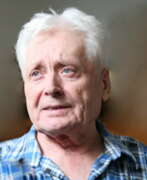

Vasily Pavlovich Borisenkov (Russian: Василий Павлович Борисенков) was a Soviet and Russian artist of the second half of the twentieth and early twenty-first centuries. He is known as a painter and teacher, a representative of the Leningrad school of painting.
Vasily Borisenkov actively participated in Leningrad art exhibitions since 1954, was the author of genre and battle paintings, landscapes and portraits. Among his famous works are the paintings "Difficult Conversation", "Spring", "Strelna. The Beginning of Summer" and many others. The master's works are in museums and private collections both in Russia and abroad.
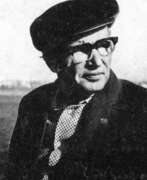

Nikolay Stepanovich Borovsky (Russian: Николай Степанович Боровский) was a Soviet Ukrainian artist of the second half of the twentieth century. He is known as a painter and teacher.
Nikolay Borovsky became famous for his portraits, landscapes and still lifes, as well as genre paintings. Some of his works were characterized by extraordinary realism. Since the early 1960s, he actively exhibited his works and in 1964 joined the Union of Artists of the USSR. For his painting "Worker. Year 1928" he received the prize of the Union of Artists of the Ukrainian SSR.
The master created a significant number of works that are in private and public collections, including a gallery of portraits of participants in the defense and liberation of Dnepropetrovsk.
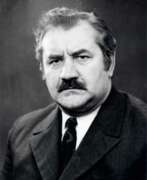

Nikolai Yakovlevich Bout (Russian: Николай Яковлевич Бут) was a Soviet artist of the second half of the twentieth century. He is known as a painter and graphic artist, a master of the battle genre.
Nikolai Bout began painting from his teenage years and immediately showed an interest in depicting historical battles. Throughout his career as a professional artist, he lived in Moscow, and spent the summer months in Kerch, where the subjects of many of his paintings originated. He painted portraits, battle and genre paintings, and landscapes. His works include the cycle "Adzhimushkay. 1942", series of paintings "Slovak National Uprising", "Heroic Marines" and other works.
Bout was an artist of the M. B. Grekov Studio of Military Artists since 1958.
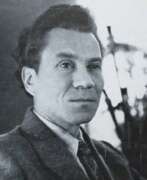

Mikhail Mikhailovich Bozhiy (Russian: Михаил Михайлович Божий) was a Soviet-Ukrainian painter, born in 1911 in Nikolaev (now Mykolaiv), Ukraine. Throughout his career, Bozhiy specialized in portraits and genre paintings, with his education grounded in the Nikolaev Art Technikum from 1930 to 1933. He began exhibiting his work in 1937, showcasing his talent in various prestigious shows, including the All-Union Art Exhibitions in Moscow during the early 1950s. His notable works, celebrated for their portrayal of Soviet citizens and landscapes, include "Svetlana Shipunova, an Outstanding Student" (1950), "A Nurse" (1955), and "My Thoughts" (1959-60), all of which are housed in the Kyiv Museum of Ukrainian Art. His contributions to Soviet art were recognized when he became a Soviet academician in 1958 and was later honored with the title of People's Artist of the USSR in 1963.
Bozhiy's life and work were deeply intertwined with the cultural and political milieu of his time. His early years were spent in Mykolaiv, but by 1936, he had moved to Odessa with his wife, where he worked as an animator at a film studio before returning to painting. His experiences during the Great Patriotic War, including creating war posters and satirical drawings, significantly influenced his artistic output. Despite health issues preventing him from serving at the front, his commitment to the war effort through his art was unwavering. Bozhiy's art is characterized by its expressive brushwork and the ability to capture the essence of his subjects, often reflecting the social and political context of the USSR.
For collectors and experts in art and antiques, Bozhiy's work offers a unique insight into Soviet-Ukrainian culture and history, highlighting the role of art in reflecting and shaping societal values. His pieces, especially those in the Kyiv Museum of Ukrainian Art, serve as a testament to his skill in portraiture and genre painting, as well as his dedication to depicting the life and people of the USSR.
For updates on new product sales and auction events related to Mikhail Mikhailovich Bozhiy, sign up now. This subscription ensures you stay informed about opportunities to acquire works by this distinguished artist and learn more about his contribution to Soviet-Ukrainian art.
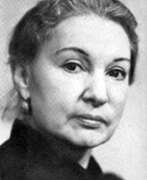

Lidia Isaakovna Brodskaya (Russian: Лидия Исааковна Бродская), a prominent Russian landscape painter, was born in St. Petersburg in 1910. As the daughter of the celebrated artist Isaak Israelevich Brodsky, she was deeply embedded in the artistic traditions of Russia from an early age. Brodskaya's educational journey in art began at a choreography college in Leningrad and continued at the Institute of Painting, Sculpture, and Architecture, concluding with mentorship under N. Krymov in Moscow. Beginning her exhibition career in 1945, Brodskaya specialized in landscapes, showcasing the vast and varied beauty of the Soviet Union.
Brodskaya's acclaim in the Soviet art world was significant, receiving the title of People's Artist of the USSR in 1980 and becoming a corresponding member of the USSR Academy of Arts in 1970. Her work earned her the State Prize of the RSFSR named after I.E. Repin in 1977, and in 1981, she was awarded the USSR Academy of Arts' silver medal. Her paintings are held in various prestigious museums across Russia and Ukraine, including Kyiv, Lviv, Chelyabinsk, and Astrakhan, celebrating her contributions to Russian art and culture.
Brodskaya's oeuvre is known for its emotional depth and technical mastery, capturing the essence of Russian landscapes with a vibrant palette and dynamic composition. Her works, such as "Blooming Apple Tree," "Ears of Rye," and "Rainbow Over the Dnieper," among others, are lauded for their depiction of the Soviet Union's natural beauty, evoking a sense of national pride and artistic innovation. Lidia Isaakovna Brodskaya passed away in 1991, leaving behind a legacy that continues to inspire and captivate art lovers and collectors.
For collectors and experts in art and antiques, Lidia Isaakovna Brodskaya's works represent a unique blend of Soviet artistic heritage and landscape artistry. Her contributions to the field remain invaluable, capturing the essence of a pivotal era in Russian art. To stay updated on sales and auction events related to Lidia Isaakovna Brodskaya, sign up for our newsletter. This subscription is your gateway to exploring the profound impact and timeless beauty of Brodskaya's art.
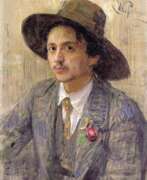

Isaak Israelievich Brodsky (Russian: Исаак Израилевич Бродский), a distinguished Russian artist, was renowned for his contributions to painting and teaching. Born in Sofievka, Russian Empire, Brodsky's artistic journey led him to become a pivotal figure in the Soviet art scene, primarily recognized for his realistic portraits and social realist works. His dedication to capturing the essence of his subjects, combined with a unique sensitivity to color and form, allowed his art to transcend mere representation, offering insights into the culture and political climate of his time.
Throughout his career, Brodsky was closely associated with significant cultural and political developments in Soviet Russia, becoming an official artist of the Soviet regime. His works, such as the iconic portraits of Lenin and other political figures, not only exemplify his skill but also serve as historical documents, offering a glimpse into the era's social fabric. His commitment to realism and the portrayal of Soviet ideals earned him a prominent place in the art world, influencing generations of artists through his role as a teacher and mentor at the Repin Institute of Arts.
Brodsky's legacy is preserved in numerous museums and galleries, with his masterpieces forming an integral part of Russia's cultural heritage. His ability to intertwine art with historical narrative has made his work a subject of study for art collectors and experts alike. For those intrigued by the depth and historical significance of Soviet art, Brodsky's oeuvre offers a fascinating exploration into the power of visual storytelling.
For collectors and experts keen on delving deeper into the rich tapestry of Russian art, staying informed about Isaac Israelievich Brodsky's work is essential. Signing up for updates ensures exclusive access to news on product sales and auction events dedicated to Brodsky's art, providing a unique opportunity to engage with the history and culture he so vividly depicted. Join us in celebrating the legacy of a true maestro of painting, whose works continue to inspire and captivate audiences worldwide.
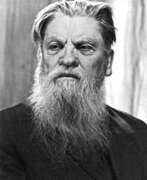

Piotr Dmitrievich Buchkin (Russian: Пётр Дмитриевич Бучкин) was a multifaceted Soviet and Russian artist known for his contributions to painting, graphic arts, and teaching. Educated at the Higher Art School at the Imperial Academy of Fine Arts under Vasiliy Mate and Vasily Savinsky, Piotr Buchkin graduated in 1912, embarking on a journey that included travels across Europe to refine his artistry. His works span a variety of genres, including portraits, genre paintings, landscapes, and illustrations, showcasing his versatility across different mediums such as watercolor, pencil, pastels, etchings, oil, and tempera paintings.
Piotr Buchkin's engagement with the art world was profound; he was a founding member of the Leningrad Union of Artists and contributed significantly to the Leningrad School of Painting. Throughout his career, Buchkin participated in numerous exhibitions and was recognized for his talent as a graphic artist and portraitist, adept in various painting techniques. His memoirs, "About that in memory: Notes of an Artist," provide insights into his artistic journey and experiences.
Piotr Dmitrievich Buchkin's works are held in prestigious collections, including the State Russian Museum and the State Tretyakov Gallery, reflecting his esteemed position in the art community. His legacy continues to inspire, as his works are found not only in Russia but also in private collections and museums worldwide.
For collectors and experts in art and antiques, Piotr Buchkin's oeuvre offers a deep dive into the richness of Soviet and Russian art, particularly the Leningrad School. To stay updated on exhibitions, sales, or auctions featuring Buchkin's works, consider subscribing to relevant updates.
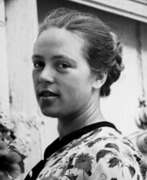

Zlata Nikolaevna Byzova (Russian: Злата Николаевна Бызова) was a Soviet and Russian artist of the second half of the twentieth and early twenty-first centuries. She is known as a painter, a representative of the Leningrad school, famous for her genre compositions, portraits, landscapes and studies from life.
Zlata Byzova achieved particular success in provincial portrait-types and Old Ladoga sketches of the 1960s-1970s. Her works were successfully presented at exhibitions and auctions of Russian painting in France in 1989-1992.
The artist's works are in museums and private collections in Russia, Finland, Germany, France and other countries.
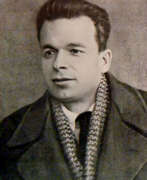

Ivan Ivanovich Cherinko (Rusian: Иван Иванович Черинько) was a Soviet Ukrainian artist who moved to Turkmenistan, after visiting Ashgabat in 1933 and finding the city beautiful and picturesque. He was among the Russian-trained artists who came to Turkmenistan and created works of art the captured the nature and culture of the republic. He founded the Union of Artists of Turkmenistan in the 1930s and co-founded the Sh. Rustaveli Turkmen Art School. In 1945, he was named an Honored Art Worker of the Turkmen Soviet Socialist Republic (Turkmen SSR, 1925–1991).
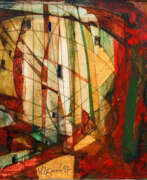

Ivan Ivanovich Chorny (Russian: Иван Иванович Чёрный) was a Soviet, Ukrainian and Russian artist of the second half of the twentieth and early twenty-first centuries. He was known for his monumental and decorative works in the style of socialist realism.
Ivan Chorny reoriented his style in the late 1990s, inventing a new technique and moving away from figurativeness in favor of abstract painting. His enigmatic compositions became an expressive expression of inner feelings enriched with colors and lines.


Semyon Afanasyevich Chuikov (Russian: Семён Афанасьевич Чуйков) was a seminal figure in the art world, bridging cultures and epochs with his unique blend of realism and vibrant colorism. Born on October 17, 1902, in Bishkek, then part of the Russian Empire, Chuikov emerged as a pioneering artist whose works deeply influenced the national school of Kyrgyzstan painting. His contributions were not confined to the canvas; he was instrumental in establishing the museum of fine arts and the first art school in Kyrgyzstan, showcasing his commitment to fostering artistic growth in the region.
Chuikov's artistry was profoundly influenced by his experiences and travels. His style, initially reminiscent of the Russian avant-garde group Jack of Diamonds, evolved to incorporate elements from his travels to India, Italy, France, Greece, and Bulgaria. This worldly exposure enriched his color palette and thematic focus, enabling him to capture the essence of Kyrgyz and Indian life with an impressive honesty and emotional depth. His work, particularly the series from India, stood out for its vivid portrayal of the common people's lives, earning him the prestigious Jawaharlal Nehru Award in 1967.
His legacy extends beyond his paintings, with his works residing in esteemed collections worldwide, including the State Tretyakov Gallery, the State Museum of Oriental Art, and the Museum of Fine Arts of Kyrgyzstan, among others. Chuikov was also a revered educator, nurturing the talents of students who would go on to become celebrated artists themselves.
For collectors and art and antiques experts, Chuikov's work represents a unique investment in cultural heritage and artistic brilliance. His ability to intertwine Kyrgyz traditions with broader artistic movements makes his work particularly appealing for those interested in the cross-cultural exchange of art.
For updates related to Semyon Afanasyevich Chuikov, including new product sales and auction events, sign up for our newsletter. Stay informed about opportunities to acquire pieces of his enduring legacy.
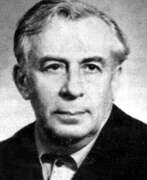

Isaac Aronovich Davidovich (Russian: Исаак Аронович Давидович) was a Soviet and Belarusian artist of Jewish origin of the second half of the twentieth century. He is known as a painter and graphic artist.
Isaac Davidovich worked in easel and monumental and decorative painting, as well as in easel and book graphics, he drew illustrations and posters. In the field of monumental art he created plafonds and panels.
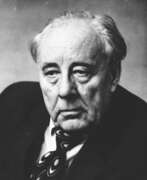

Mykhailo Hordiiovych Derehus (Russian: Михаил Гордеевич Дерегус) was a prominent Soviet Ukrainian graphic artist, painter, and educator, renowned for his significant contributions to the visual arts in Ukraine. Born on December 5, 1904, in Veseloye, Kharkiv Oblast, Derehus' artistic journey began at the Kharkiv Art Institute, where he not only honed his skills but also later imparted knowledge as a lecturer. His diverse body of work spans thematic painting, landscapes, still lifes, portraiture, etching, and book illustration, demonstrating his versatility across different mediums.
Derehus' art, particularly his expressionist lithographs, played a crucial role in illustrating significant Ukrainian literary works, such as Ivan Kotliarevsky's "Eneïda" and the writings of Nikolai Gogol, Lesya Ukrainka, Marko Vovchok, and Natan Rybak. His illustrations are celebrated for their depth and ability to capture the essence of the Ukrainian spirit. A testament to his mastery and significant impact on Ukrainian art, Derehus was awarded the prestigious Shevchenko National Prize in 1969. His legacy includes his leadership as Chairman of the National Union of Artists of Ukraine from 1955 to 1962 and his works being held in esteemed collections such as the Kuindzhi Art Museum in Mariupol, Ukraine.
For collectors and experts in art and antiques, Derehus' work represents a vital link in the chain of Ukrainian cultural heritage, offering unique insights into the nation's artistic evolution. His contributions have not only enriched Ukrainian visual arts but also ensured that the beauty of Ukraine's landscapes, its historical narratives, and the richness of its folklore continue to inspire future generations.
If you're intrigued by the artistic legacy of Mykhailo Derehus and wish to explore more about his works and their significance in the realm of Ukrainian art, consider signing up for updates. This subscription will keep you informed about new product sales and auction events related to Derehus, offering exclusive opportunities to connect with the rich tapestry of Ukrainian cultural expression.


Hamed Ewais is an egyptian artist. Ewais graduated from the Cairo’s School of Fine Arts in 1944, later he continued his studies at the Royal Academy of Fine Arts of San Fernando in Madrid, returning to teach at the Faculty of Fine Arts in Alexandria. Ewais was of the founders of the Group of Modern Art in 1947 along with several artists. In 1956, he was awarded the Guggenheim International Prize. Influenced by key figures of Mexican muralism such as Diego Rivera and David Alfaro Siqueiros, Ewais chose to work in an aesthetic style that reflected his socialist political leanings. As one of Egypt’s leading social realist painters, Ewais highlighted the plight of the country’s working class and was a proponent of Nasser’s Pan Arab movement.
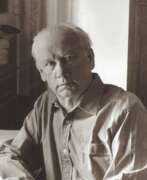

Pyotr Timofeyevich Fomin (Russian: Пётр Тимофеевич Фомин) was a distinguished Russian artist, renowned for his contribution to Soviet landscape painting. Born on October 18, 1919, in Lediakha, Pskov Region, Fomin was acclaimed for his poignant and poetic depictions of the Russian countryside. His artistic journey flourished after World War II when he studied at the Repin Academy, leading to a lifelong career in teaching and creating art that resonated with the lyrical beauty of rural Russia.
Fomin's work is characterized by its deep nationalistic themes and the serene portrayal of landscapes, which often reflected his profound love for his homeland. His favorite subjects included the changing seasons of his native Pskov, capturing the essence of Russian life and nature with an almost ethereal quality. His achievements in the arts earned him prestigious titles such as the People's Artist of the USSR, and his paintings are featured in prominent collections across the world, including the State Russian Museum and the Tretyakov Gallery.
Throughout his career, Fomin participated in numerous exhibitions, both domestically and internationally, helping to foster a greater appreciation for Soviet art globally. His legacy continues to inspire artists and collectors alike, and his works are a testament to the rich cultural heritage of Russia.
For those interested in the captivating landscapes and historic insights of Pyotr Fomin's work, consider signing up for updates on upcoming sales and auction events featuring his art. This will ensure you are always informed about the opportunity to own a piece of this masterful artist's legacy.
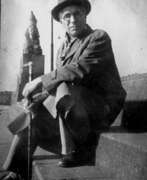

Rudolf Rudolfovich Frentz (Russian: Рудо́льф Рудо́льфович Фре́нц) was a Soviet and Russian painter, watercolorist, graphic artist, and art teacher, known for his contributions to the Leningrad School of Painting. Born on July 23, 1888, in Marienburg, a suburb of Saint Petersburg, he studied at the Imperial Academy of Arts under Vasily Savinsky and Nikolai Samokish. Frentz's early work focused on battle scenes, which became a hallmark of his style.
Frentz's work is celebrated for its dynamic composition and attention to historical detail, particularly in his depictions of military scenes. He was a member of the Leningrad Union of Artists and was deeply involved in the artistic community of Leningrad. His paintings, which often portrayed the heroism and struggles of Soviet soldiers, were exhibited in numerous prestigious shows and galleries throughout his career.
Notable works by Frentz include paintings like "Battle of Borodino" and "Storming of the Winter Palace," which are admired for their dramatic intensity and historical accuracy. His legacy continues to be honored in Russian art history, with his works held in collections such as the State Russian Museum and the Tretyakov Gallery.
Stay updated on new product sales and auction events related to Rudolf Rudolfovich Frentz by signing up for our updates. This subscription will only notify you of relevant sales and events.
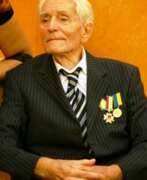

Albin Stanislavovich Gavdzinsky (Russian: Альбин Станиславович Гавдзинский) was a Soviet and Ukrainian artist of the second half of the twentieth and early twenty-first centuries. He is known as a painter, famous for his landscapes, genre paintings and portraits.
Albin Gavdzinsky in the early 1950s held his first solo exhibitions in Odessa, Kiev and Kharkov and showed his bright artistic personality. The artist was distinguished by his outstanding efficiency and precision in depiction, which was evident in his clear forms and bright colors. In 1961 he was recognized as Honorary Citizen of the city of Novaya Kakhovka, and his works (237 canvases) served as the basis for the creation of the city's art gallery, which in 2003 was named after him.


Aleksandr Mikhailovich Gerasimov (Russian: Алекса́ндр Миха́йлович Гера́симов) was a Russian and Soviet painter, born on August 12, 1881, in Kozlov (now Michurinsk), in the Tambov Governorate of the Russian Empire. He is best recognized for his leading role in promoting socialist realism in visual arts, notably through his portraits of Joseph Stalin and other Soviet leaders. Gerasimov's education at the Moscow School of Painting, Sculpture, and Architecture honed his skills, guided by masters like K.A. Korovin, A.E. Arkhipov, and V.A. Serov. His style, a blend of academic realism with impressionistic influences, vividly depicted the Russian landscape, leaders, and the daily life of the Soviet era.
His works, rich in emotionality and composition mastery, span across various themes from state portraits to landscapes and still lifes, showcasing a deep love for the Russian landscape's innate beauty. Gerasimov's contributions to art include not only significant political portraits but also captivating scenes of nature and life in Russia, marked by their emotional depth and vibrant colors. His paintings like "Stalin and Voroshilov in the Kremlin" won him the Stalin Prize in 1941, cementing his status in Soviet art history.
Gerasimov's artistry extends beyond his political work; his landscapes and portrayals of Russian expanses convey a deep lyrical sentiment, reflecting his profound connection and love for his homeland. His mastery across various mediums—oil, watercolor, gouache, and more—allowed him to explore and express a wide range of subjects, from portraits and landscapes to still lifes, showcasing his versatility and depth as an artist.
For those interested in the intersection of art and history, Aleksandr Mikhailovich Gerasimov's work offers a fascinating window into Soviet-era Russia, its leaders, and its landscapes. To stay updated on exhibitions and sales of Gerasimov's works, sign up for updates specifically focused on new product sales and auction events related to this distinguished artist.
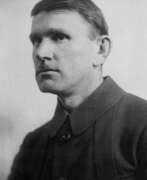

Sergey Vasilyevich Gerasimov (Russian: Серге́й Васи́льевич Гера́симов) is a celebrated figure in the annals of Russian art, known for his adept navigation through various artistic movements, transitioning from Impressionism to the robust narratives of Socialist Realism. Born in Mozhaisk, Russia, in 1885, his multifaceted career spanned painting, teaching, and book illustration, marking him as a versatile artist and educator. Educated under prominent figures such as Konstantin Korovin, Gerasimov dedicated a significant part of his life to nurturing the next generation of artists.
His artistic oeuvre is notable for its versatility and emotional depth, capturing the Soviet ethos with a unique blend of realism and evocative landscape and genre paintings. His work during critical periods in Soviet history, including the Stalin era and World War II, offers a vivid portrayal of the times. Gerasimov's mastery is evident in celebrated pieces like "The Peasant Uprising of 1860" and "Collective Farm Holiday," which are held in high esteem and displayed in prestigious venues such as the Tretyakov Gallery.
Gerasimov's legacy extends beyond his paintings. As an influential teacher at the Surikov Art Institute, he shaped the careers of numerous Soviet artists, leaving a lasting impact on the artistic landscape. His dedication to art and education has cemented his status as a revered figure in the history of Russian and Soviet art.
For those interested in the rich heritage of Russian art, Sergey Vasilyevich Gerasimov's life and work present an invaluable perspective on the cultural and political shifts of his era. His legacy continues to inspire and influence, making his art a focal point for collectors and art aficionados alike.
To stay abreast of the latest findings and exhibitions featuring Gerasimov's compelling works, signing up for updates is highly recommended. This subscription will ensure that enthusiasts are well-informed about upcoming sales and auction events showcasing the timeless creations of Sergey Vasilyevich Gerasimov.


Herman Moiseyevich Gold (Russian: Герман Моисеевич Гольд) is a Soviet, Ukrainian and contemporary Israeli artist. He is known as a painter, draftsman, and watercolorist, renowned for his expressive style of painting.
Herman Gold is skilled in both oil painting and watercolor, and often gives his works a dramatic character. He is one of the few contemporary Jewish artists to be included in the legendary World Encyclopedia of Artists of All Time.
His works are in museums and galleries in many countries, including Russia, Ukraine, France, Greece, the United States and others.
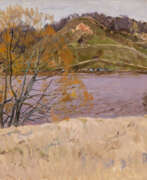

Yakov Andreevich Golubev (Russian: Яков Андреевич Голубев) was a Soviet artist of the mid-twentieth century. He is known as a painter, a representative of the Leningrad art school.
Yakov Golubev began participating in exhibitions while still studying at the painting faculty of the Leningrad Institute of Painting, Sculpture and Architecture. He became famous for his lyrical landscapes. Among his famous works are the paintings "Quiet Day", "Wicket Gate", "Late Autumn" and others.
The master's works are in museums and private collections all over the world, including Russia, Japan, Italy, Germany and France.


Vladimir Alexandrovich Gorb (Russian: Влади́мир Алекса́ндрович Го́рб) was a Soviet Russian artist, renowned for his versatile talents in painting, graphic design, and art education. Born on December 31, 1903, in Odessa, Russian Empire, Gorb carved a niche for himself in the Leningrad art scene, contributing extensively to its richness and diversity.
Gorb's education at the Leningrad VKHUTEIN under influential teachers like Alexander Savinov and Kuzma Petrov-Vodkin equipped him with a formidable artistic foundation, which he expanded upon throughout his career. His works, characterized by their vivid portrayal of everyday life and the natural world, were regularly featured in prominent exhibitions from as early as 1925.
Over the years, Gorb became a significant figure in the Soviet art community, not only through his artwork but also through his role as a professor at the Repin Institute of Arts. His commitment to art education shaped many future artists. His works are notable for their depth and complexity, encapsulating the Soviet ethos with a unique blend of realism and personal expression.
For those interested in exploring the works of Vladimir Gorb further or acquiring pieces for their collections, more information is available through dedicated art galleries and historical art resources online. For updates on exhibitions and available works of Vladimir Gorb, you can subscribe to our newsletter, ensuring you're informed about new sales and auction events related to this distinguished artist.


Gavriil Nikitich Gorelov (Russian: Гавриил Никитич Горелов) was a Russian and Soviet artist of the first half of the twentieth century. He is known as a painter, graphic artist and teacher.
Gavriil Gorelov studied at the St. Petersburg Academy of Arts under Ilya Repin and Franz Roubaud. He created historical canvases, genre paintings and portraits. During a study trip to Italy, he painted "Orgy in the apartments of Alexander VI Borgia". Returning to Russia, the artist became a member of the Association of Traveling Art Exhibitions. Among his famous works are "Pugachev's Trial of a Landowner", "Pugachev's Execution", "Bolotnikov's Revolt", "Minin's First Appeal to the People", "Dogs-Knights". He also participated in the creation of the panorama "The Storming of Perekop".
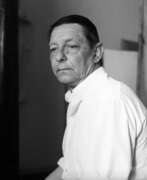

Anatoly Andreevich Gorpenko (Russian: Анатолий Андреевич Горпенко) was a Soviet artist of the mid-twentieth century. He is known as a painter and graphic artist, battle painter and portraitist.
Anatoly Gorpenko served as a war artist during the Great Patriotic War, creating propaganda posters and front sketches. His oeuvre includes pictorial works, including battle scenes and portraits of military figures. He also participated in the creation of dioramas and panoramas, and his works, including stained glass windows and mosaics, decorated monuments and buildings, including in Berlin.
Gorpenko also did graphics for publishers and magazines and created political posters.
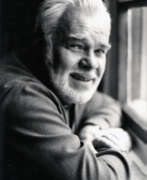

Vitaly Nikolaevich Goryaev (Russian: Виталий Николаевич Горяев) was a celebrated Soviet graphic artist, illustrator, painter, and caricaturist, born on April 14, 1910, in Tobolsk province, and passed away on April 12, 1982, in Moscow. He embarked on his artistic journey after his family moved to Chita in 1921, where he first published his drawings in the local newspaper. Goryaev's notable achievements include first-degree diplomas at the All-Union Contests "Best Books" for his illustrations to "The Adventures of Huckleberry Finn" and Gogol's "Petersburg Stories". His work was also internationally recognized, evidenced by a diploma II degree at the International Book Exhibition in Bratislava in 1967 for "Petersburg Stories", and in 1969, he was awarded the Gold Medal of the Czechoslovak Union of International Relations. Goryaev's illustrations spanned works by Russian classics like Pushkin, Gogol, and Dostoevsky, contributing significantly to the visual representation of these literary giants' works.
A laureate of the State Prize of the USSR (1967) for his contributions to illustrating Gogol's "Petersburg Stories", Goryaev was honored with the title of People's Artist of the RSFSR in 1976, and later, People's Artist of the USSR in 1981, marking his significant contributions to Soviet art. His legacy includes a profound impact on the illustration of literature, with his works being housed in prestigious collections such as the State Tretyakov Gallery, the Russian Museum, and the Pushkin Museum of Alexander Pushkin.
Goryaev's style was known for its expressive detail and ability to capture the essence of the literary works he illustrated, making his art an integral part of Soviet visual culture. His son, Sergei Vitalevich Goryaev, continues the artistic lineage as an artist, preserving the family's contribution to Russian art.
For collectors and experts in art and antiques, Goryaev's works represent a unique intersection of Soviet history, literature, and visual arts, offering a glimpse into the rich cultural tapestry of the era. His illustrations are not only important for their artistic value but also for their historical significance, embodying the spirit and challenges of Soviet society.
To stay updated on events, sales, and auctions related to Vitaly Nikolaevich Goryaev's work, sign up for updates. This subscription ensures you remain informed about opportunities to acquire pieces of this influential artist's legacy, highlighting moments when his works become available in the market.
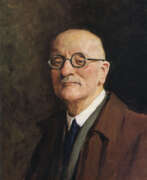

Igor Emmanuilovich Grabar (Russian: И́горь Эммануи́лович Граба́рь) was a distinguished Russian painter, art historian, and museum administrator, whose contributions have left an indelible mark on the world of art. Renowned for his versatility, Grabar was not only a masterful artist but also a visionary in art preservation and education. His work reflects a deep appreciation for Russia's cultural heritage, capturing the essence of its landscapes, historical moments, and architectural beauty with a unique blend of realism and impressionism.
Grabar's significance extends beyond his paintings; he played a pivotal role in the preservation of Russian art, overseeing restoration projects and establishing guidelines that are still in use today. His efforts in cataloging and promoting Russian art helped to elevate the profile of Russian culture on the global stage. Among his well-known works, "February Azure" stands out for its captivating use of color and light, showcasing Grabar's skill in conveying the beauty of Russian winters.
As an educator and museum director, Grabar influenced generations of artists and art historians, embedding a deep respect for artistic heritage and innovation. His leadership at the Tretyakov Gallery and involvement in various art schools helped to shape the direction of Russian art in the 20th century. Grabar's legacy is not just in his artworks but also in his contributions to art education and museum practices, making him a revered figure among collectors, experts, and enthusiasts of art and antiques.
For those passionate about the rich tapestry of Russian art and culture, Igor Emmanuilovich Grabar's work remains a source of inspiration and admiration. We invite collectors and art experts to sign up for updates on new product sales and auction events related to Grabar's work. This subscription is your gateway to the world of a visionary artist whose influence continues to resonate in the art world.


Otto Griebel was a German artist of the twentieth century. He is known as a painter and graphic artist who worked in the directions of "new subject matter" and socialist realism.
Griebel joined the Dadaists after World War I and was a member of the Dresden Dadaist group. He participated in various artistic associations, including the Dresden Secession Group, the Aktion group of artists, the Association of Free Artists of Saxony, and others. In 1933, the artist was arrested by the Gestapo and his work was recognized as "degenerate art". Most of the master's work was lost during the bombing of Dresden in 1945.
Griebel was also a talented puppet theater artist and created sets for puppet shows.
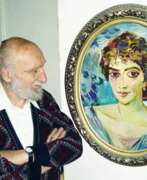

Alexander Ovakimovich Grigoryan (Russian: Александр Овакимович Григорян) was a Soviet and Armenian artist of the second half of the twentieth and early twenty-first centuries. He is known as a painter and graphic artist, portraitist and illustrator.
Alexander Grigoryan painted pictures characterized by bright saturated colors and emotionality. He specialized in portraits of well-known personalities, whose images he conveyed with warmth and empathy. His works did not just reflect faces, but also conveyed the inner world and temperament of each person depicted.
The master also illustrated works by Shakespeare and Armenian writers.


Sergey Alekseyevich Grigoryev (Russian: Сергей Алексеевич Григорьев) was a distinguished Soviet and Ukrainian artist, born in 1910 in Lugansk, Ukraine. With a rich educational background from the Zaporozhe Arts and Crafts School, Moscow VKHUTEMAS, to the Kiev Art Institute, Grigoryev's journey in the arts began early and was marked by significant achievements and contributions. He became a beacon of Socialist Realism, earning accolades such as the Stalin Prizes in 1950 and 1951, and the prestigious title of People's Artist of the USSR in 1974.
Grigoryev's work spans a variety of genres, including genre art, portraiture, and educational pieces that delve into themes of family, Soviet life, and the nurturing of young minds. His art is celebrated for its attention to detail, the vibrancy of national characteristics, and an unwavering commitment to depicting the truthfulness of life. Among his notable works are "Admission into the Komsomol" and "The Goalkeeper," housed in the Tretyakov Gallery, which exemplify his masterful portrayal of everyday life and the human condition.
His paintings, like "Nuvole estive" and "Bambina che disegna," have found places in esteemed auctions, reflecting the enduring value and appeal of his work to collectors and art enthusiasts. As an educator and a member of the USSR Academy of Arts, Grigoryev's legacy extends beyond his canvas, influencing generations of artists and shaping the landscape of Soviet and Ukrainian art.
For collectors and experts in art and antiques, the work of Sergey Alekseyevich Grigoryev offers a window into the soul of a period rich with history and transformation. His oeuvre represents not only the pinnacle of artistic achievement under the banner of Socialist Realism but also a deeply personal exploration of the human experience. To stay updated on sales and auction events featuring Grigoryev's work, signing up for updates is a step towards owning a piece of this historic tapestry.
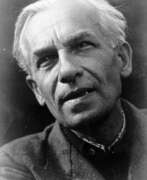

Hans Grundig was a German artist of the first half of the twentieth century. He is known as a painter, graphic artist and teacher, professor and rector of the High School of Fine Arts in Dresden, and husband of the artist Lea Grundig.
Grundig produced works that stylistically belong to the "new materiality" and revolutionary-proletarian realism. In 1932 he visited the USSR, where he participated in the exhibition "Revolutionary Art in Capitalist Countries" in Moscow. His art during this period was strongly anti-fascist, the works were created in a realistic-expressive style. After the Nazis came to power, he was banned from painting and his works were recognized as "degenerate art". The artist was arrested and sent to the Sachsenhausen concentration camp.
Grundig's paintings today are an important part of the golden fund of realist art in twentieth-century Germany.
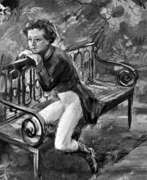

Boris Nikolayevich Gushchin (Russian: Борис Николаевич Гущин) was a Soviet and Russian artist of the second half of the twentieth century. He is known as a painter, graphic artist and author of diafilms.
Boris Gushchin created many diafilms, including "The Lonely White Sail", "Joke", and "Coats of Arms of Your Country". As a painter, he specialized in Russian landscapes, portraits and works dedicated to Pushkin, particularly illustrations for his works.


Renato Guttuso was a twentieth-century Italian painter and graphic artist. He is known as a brilliant representative of neo-realism.
Renato Guttuso was one of the founders of the "New Art Front". - a revolutionary artistic movement that emerged in Italy after World War II.
Guttuso's paintings have a pronounced social orientation, his work combines Expressionism, Cubism and Realism. He also designed sets and costumes for the theater and created illustrations for books.
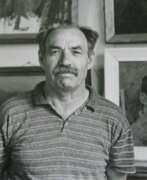

Theodor Theodorovich Herzen (Russian: Теодор Теодорович Герцен) was a Soviet and Kyrgyz artist of the second half of the twentieth and early twenty-first centuries of German origin. He is known as a painter, graphic artist, muralist, who was honored with the title of People's Artist of Kyrgyzstan.
Theodor Herzen worked in monumental and decorative art, easel painting and book graphics. One of Herzen's outstanding works was a monumental cycle of illustrations to the Kyrgyz epic "Manas", including more than two hundred linocuts. In this project, he combined his extensive experience of working on Kyrgyz themes with his deep knowledge of the ethnicity, history and spiritual traditions of the Kyrgyz people. Herzen collected extensive ethnographic material and created many sketches of costumes and scenes from Kyrgyz life for this cycle of illustrations.
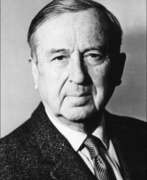

Mykola Petrovich Hlushchenko, a prominent Ukrainian post-impressionist painter, was born in 1901 in Novomoskovsk, Russia, and is celebrated for his diverse artistic contributions that span across various European landscapes, still life, nudes, and notable portraits. His early exposure to art in Yuzivka (now Donetsk), and further education at the Academy of Art in Berlin in 1924, laid the foundation for his illustrious career. Hlushchenko's work caught the attention of French critics soon after he moved to Paris in 1925, marking his transition from the New Objectivity style to post-Impressionism.
Hlushchenko's involvement with the Association of Independent Ukrainian Artists in the early 1930s, and his exhibitions across major European cities and the United States, underscored his role as a leading figure in Ukrainian post-impressionism. His work was characterized by vibrant color use and a unique blend of styles influenced by his time in Germany, France, and later in the Soviet Union. Throughout his life, Hlushchenko's art reflected his extensive travels and deep appreciation for landscapes, earning him numerous awards including the Shevchenko National Prize in 1972.
For art collectors and enthusiasts, Hlushchenko's pieces not only represent the zenith of Ukrainian post-impressionism but also embody the artist's rich, multifaceted life experiences. His paintings, such as the portraits of Oleksandr Dovzhenko and Volodymyr Vynnychenko, along with commissioned works for the Soviet government, showcase his adaptability and mastery over his medium.
To stay informed on Mykola Petrovich Hlushchenko's works and related auction events, signing up for updates is advisable. This subscription ensures you're always in the loop for new sales and exhibitions, enriching your collection with the vibrant legacy of a distinguished Ukrainian artist.
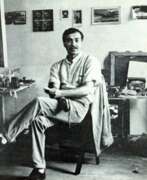

Sergey Israelovich Hovsepyan (Russian: Сергей Исраелович Овсепян) is a Soviet and contemporary Armenian artist. He is known as a painter working in different genres, but predominantly in portraiture and everyday life.
Sergey Hovsepyan began exhibiting his works in 1972. His work is distinguished by plastic diversity and aspiration to convey the actual problems of the time. He skillfully combines form and content, adjusting plastic principles to each theme. His large thematic paintings reflect an analytical and cognitive approach to the study of reality. The artist often introduces documentary material, photo and newsreel footage into his paintings.


